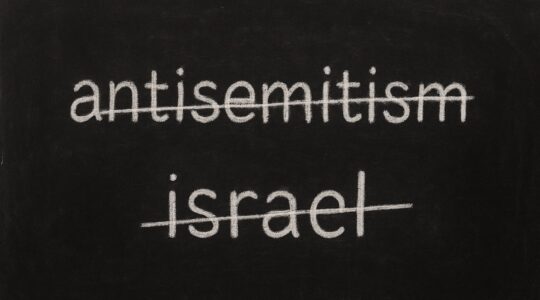Throughout the Middle Ages, Jews and Christians were consumed by hateful polemics about each other. They fought theological duels that sometimes led to deadly Christian violence against our ancestors. Christians no longer pose any existential threat to Jews, yet the penchant for hateful language has continued, particularly in my Orthodox community. Much of this venom is directed against ourselves in fraternal battles that are turning as lethal as the medieval Jewish-Christian warfare. Today the traditional fear and vilification of gentiles has been transferred to other Orthodox Jews with whom we disagree.
When we step back from the fray, are we not horrified to realize that many of us see Jews holding different Torah views the same way we saw our gentile enemies of the past? Can’t we see that this vicious strife is eroding our souls and corroding our communal bonds?
The recent decision by the principal of the Orthodox SAR high school to allow girls to wear tefillin became a tripwire for nasty talk under the guise of Torah and halacha. To be sure this decision permitted a change in traditional Jewish practice, which is a serious matter for halachic Jews. Much hangs on getting this question right. It needs to be analyzed with utmost integrity, so we can arrive at a conclusion consistent with the cannons of halachic procedure and practice.
Yet there has been little calm and deliberate discourse in the blogs, “shiurim” and lectures on the controversy. Instead, we were inundated — from both sides — with mean-spirited rhetoric, false accusations, demonization, impugning the motives of good people and besmirching their reputations through guilt by association. Some who supported the decision portrayed opposing rabbis as power-hungry authoritarians or narrow-minded haredim, while some rejecting the decision painted the supporting rabbis as halachic ignoramuses and weak-willed traitors to the “mesorah” (tradition). Oblivious to the facts, one rabbi could only understand the permissive decision as motivated by unclean mercenary motives, while another proclaimed that the controversy raised issues of shmad (apostasy) and Torah violations for which a Jew must die rather than commit. And on the lips of many was eviction from house of Orthodoxy. This is not the talk of true Torah scholars who strive to understand and analyze; it is willful distortion and irresponsible exaggeration.
There are good reasons why our Talmudic sages caution Torah scholars “to be careful with their words.” They understood that stridency, denunciations and hysteria demonstrate weakness and the lack of serious conviction. Only people without good reasons or logical arguments resort to ad hominem attacks, name-calling and misuse of facts. Hostile rhetoric hurts many and it convinces no one. On the contrary, it alienates good souls. As happened to the Talmudic scholar Resh Lekish, verbal violence causes people to give up on the bet midrash. Intelligent listeners see the irrationality immediately, while morally sensitive listeners chafe at its overwhelming meanness. And those outside the Orthodox community witnessing the rhetorical wars conclude “a pox on both their houses.” Why should anyone want to be a part of this coarse Torah life?
We need to believe strongly in our halachic positions, yet resist hostility and vitriol. This is what the great masters of our halachic tradition, the Talmudic sages, did. They strove to understand those who differed. They argued logically, presented the reasons for their decisions and tried to demonstrate patiently and cogently why their own rulings should carry the day. This was how the Talmudic sage, Hillel, conducted his halachic disagreements with Shammai. As the Mishnah teaches, Hillel’s positions proved determinative precisely because he presented Shammai’s rulings carefully, honestly and respectfully before arguing his own positions. He did not appeal to unthinking obedience or accuse Shammai of ignorance or heresy. His language reflected intellectual honesty and his behavior accorded Shammai honor. So his rulings merited becoming the Torah of Israel.
Are not all Jews responsible for and accountable to each other? Would it not be more effective, a greater kavod to the Torah— indeed more religious — if Orthodox rabbis aired their disagreements in the presence of each other, showing respect for their colleagues? Godly people strive to understand their counterparts, being ever cognizant that their opponents are also created in the Image of God and that good people can differ out of pure motive.
Should we not love each other without making that love conditional on seeing the Torah our way? This was the way of Hillel and traditional Torah scholars, and also of Rabbi Jonathan Rosenblatt of the Riverdale Jewish Center. With scholarship, love, fairness and respect, Rabbi Rosenblatt recently explained his objections girls to wearing tefillin——and did so in the presence of the principal of SAR. His presentation was honest, cogent and compelling. And the caring and respect he demonstrated for those he differed with should standards for halachic discourse. Yet his tone is the exception that stands in bold relief to the other public rabbinic responses to the controversy.
Whether women may wear tefillin is no small matter for halachic Jews, yet I suspect that it will not determine the survival of Torah life. But whether we choose to demonize, mischaracterize and deny room for those who disagree with us may well spell the difference between Orthodox survival and our demise.
It is a terrible and dangerous arrogance to believe that you alone are right, that you have a magical eye that sees the truth, and that there is one and only one correct answer to questions of theology and practice. According to the Talmud, Rabbi Akiva’s students thought this way, and their disrespect brought a plague upon Israel that killed thousands of Torah scholars. When our rabbis brook no honest dissent, when they are self-righteous and intolerant, they threaten the future of our people.
The great rabbinic leader R. Naftali Zvi Yehuda Berlin (Netziv) also understood this fact of life. He taught that our patriarchs, Abraham, Isaac and Jacob were righteous people (“yesharim”) who got along even with their pagan neighbors. By contrast, the “righteous” tzadikim of the Second Temple were consumed by intolerance, believing that anyone who disagreed with them was a heretic to be excommunicated. The result was the destruction of the Second Temple and the exile of our people.
“The Holy One,” insisted Netziv, “does not tolerate ‘tzadikim’ like these.”
The Talmud records the caring manner of Hillel to teach us a critical religious lesson. As in Hillel’s time, Jews today will flock to Torah life when they hear tones of patience and reason, of honesty and love emanating from Torah scholars. Torah becomes compelling when rabbis demonstrate the strength of their convictions yet find a way to disagree civilly, and when Jews pay heed to the Torah imperative to uphold the honor of others.
All of us need to do a better job imitating the God of Israel, the Holy One, Blessed be He, Who creates each person different from his neighbor and Whose seal is Truth. And as the Divine showed the priestly Aaron, He tolerates His children when they err honestly. The God of Israel built the world with chesed and He longs for all His children to do so also.
Rabbi Dr. Eugene Korn is American director of the Center for Jewish-Christian Understanding in Efrat. His recent books include “Jewish Theology and World Religions” and “Covenant and Hope.”
The New York Jewish Week brings you the stories behind the headlines, keeping you connected to Jewish life in New York. Help sustain the reporting you trust by donating today.




